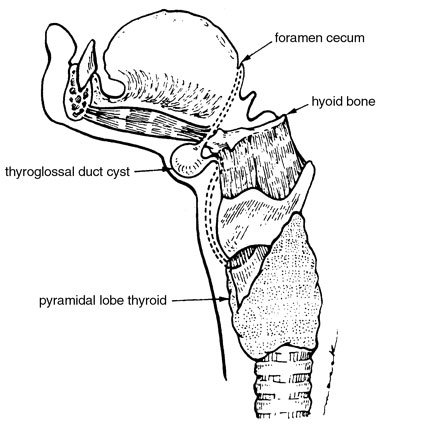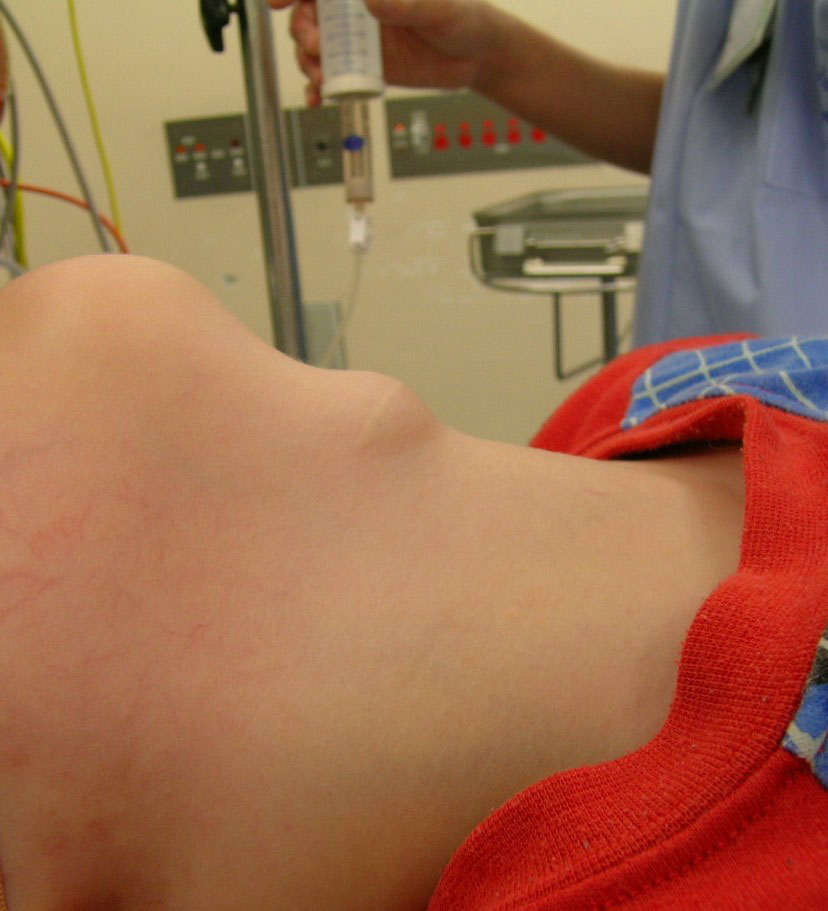Thyroglossal Duct Cysts
During fetal development, the thyroid develops from cells in the back of tongue which descend to the base of the neck. A thyroglossal duct cyst is a deposit of cells that form a cyst along the migratory path that the thyroid takes. It forms a lump at or near the midline on the neck. It usually contains clear fluid and tends to increase in size with time. If not removed there is risk of infection.


How is a thyroglossal duct cyst treated?
Thyroglossal duct cysts are treated with surgery. The aim of the procedure is to remove the whole cyst without rupture. The cyst is removed along with the central portion of the hyoid bone in order to avoid recurrence. The operation is performed under general anaesthesia and takes about 30 minutes. Your child should not have to spend the night in hospital
Thyroglossal duct cysts do not go away on their own. If they are not removed, there is a risk of infection. If infected, treatment with antibiotics or occasionally a small operation to drain pus is required. Infection also increases the risk of recurrence once the thyroglossal duct cyst is ultimately removed.
Preoperative Preparation
Your child cannot eat for 6 hours before the procedure. Your child can drink water for up to 2 hours before the operation. The Day Surgery Unit will instruct you the day before surgery to confirm fasting times. It is useful to bring your child’s favourite toy along on the day.
Anaesthesia
The anaesthetist will meet you and your child prior to the procedure. They will discuss the anaesthetic with you and take you through to the operating theatre. Your child will be anaesthetised using a face mask and then you will be taken to a waiting area. Once your child is asleep a drip is inserted often in the hand or arm, but occasionally it may need to be sited in the leg.
Procedure
The operation is done through an incision in the neck. The cyst is removed carefully to avoid rupture. Additional structures removed include the central portion of the hyoid bone and the track between the hyoid and the floor of the mouth. Local anaesthetic is injected to numb the area. The wound is closed with absorbable sutures which are under the skin. Tissue glue is applied as a dressing. It is lilac in colour and takes 2 weeks to fall away. The whole operation takes around 30 minutes.
Initial recovery
On completion of the operation your child will be taken to the recovery area. Children often initially appear distressed and a little confused upon waking up but will quickly settle down once you are with them and if offered a drink or something to eat. Full recovery usually takes about 2-3 hours after which you can go home.
Post-operative course
Children’s paracetamol should be given for pain relief for 24 hours. After that use paracetamol only if needed. Some children need additional medication such as ibuprofen or celecoxib. Opiate (morphine-type) medications are not usually required. Paracetamol and ibuprofen can be given at the same time and work well together. Follow the dosages recommended on the packaging or by the anaesthetist. Never give more than has been prescribed.
In general, your child may eat a normal diet after surgery. Vomiting is common on the day of surgery. It is temporary, and usually due to the anaesthetic and pain-relief medications that are used. If vomiting occurs, start with clear liquids and add solids slowly for the first day.
Return to activity
- Activity: Your child should avoid strenuous activity first 1-2 days. Sport and swimming are best avoided for 3 weeks after surgery.
- School: Your children may return to day care or school when comfortable.
- Bathing/showering: As the wound is waterproof, bathing and showering is safe after the operation.
- Wound care: No specific wound care is required. The stitches are absorbable and do not require removal. No dressing changes, creams or ointments are required.
- Stool softeners and laxatives: May be needed to help regular stooling after surgery, especially if opiates are needed for pain.
Call the doctor’s office if:
- You see any signs of infection: redness along the incision site, increased swelling, discharge
- Your child’s pain gets worse or is not relieved by pain killers
- There is bleeding from the incision
- Your child has an abnormal temperature
- Vomiting continues on the day after surgery
- If you have any other concerns
Follow-up
I will review your child 4-6 weeks after the surgery to ensure healing of the wound. For patients from rural areas this may be deferred to your local General Practitioner or Paediatrician. Please ring soon after the operation to arrange a convenient time.
Complications
This is a common operation with a low complication rate. The vast majority of children who have this operation recover well and have no serious complications of surgery. However, complications can occur. Some of the recognised ones include:
Recurrence
The chance of recurrence is <1%. The recurrent hernia will show up as a lump in the same spot. If the hernia recurs further surgery will be required to correct it.
Infection & Bleeding
There is a 1-2% risk of bleeding or wound infection after surgery. The wound will appear red, be tender to touch and may discharge pus or blood. If this occurs, a course of antibiotics may be required, and you should contact me or present to your General Practitioner or Local Hospital as soon as possible.
More Information
If you have any questions, please do not hesitate to contact us.
Ph: 02 8307 0977
Fax: 02 8088 7420
Email: info@drgideonsandler.com
Please refer to the following resource for more information:
- Thyroglossal Duct Cyst
Children's Hospital of Philadelphia
This page is intended to provide you with information and does not contain all known facts about thyroglossal duct cysts. Treatment may have uncommon risks not discussed here. Please do not hesitate to ask any questions you may have.